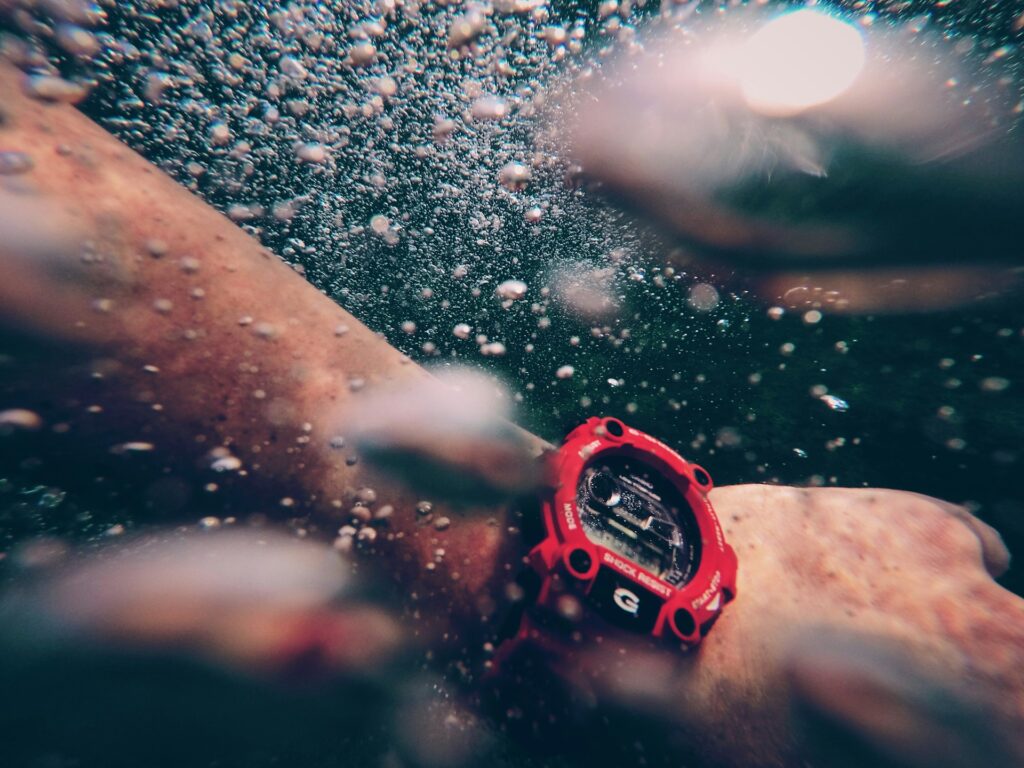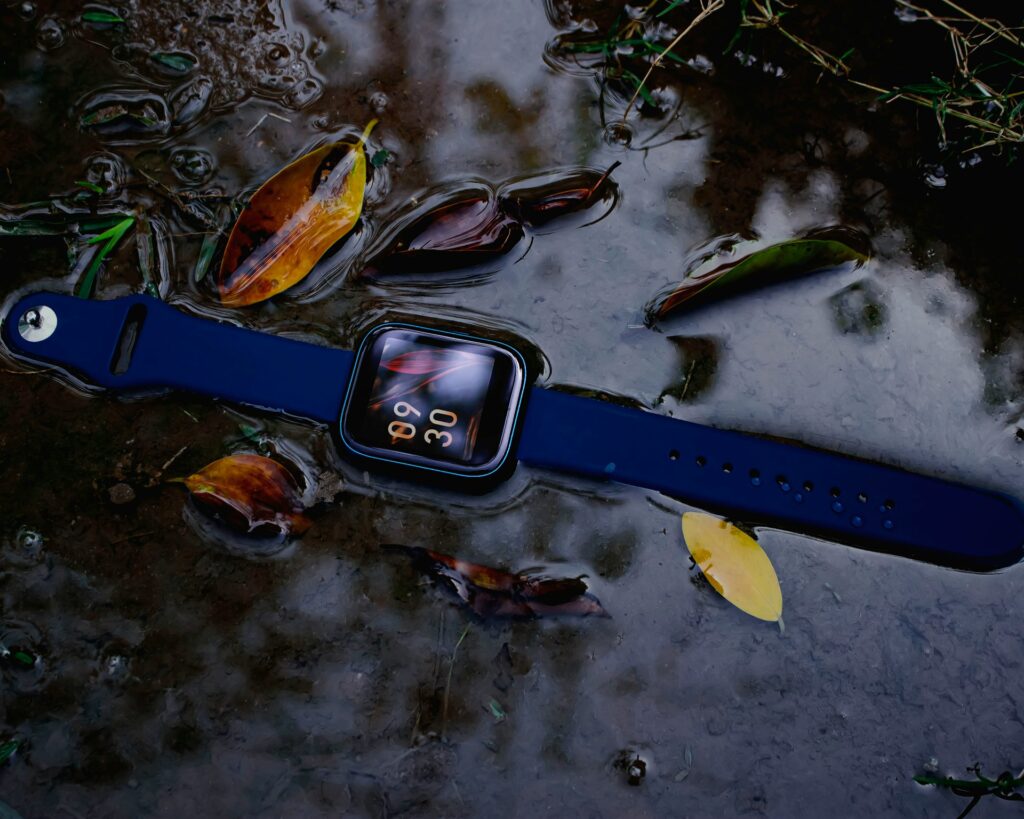Learn about Can We Use a Watch During Swimming. Discover if you can use a watch during swimming, water resistance ratings, top swim watches, and tips for safe, effective swim tracking and care.
Swimming watches are waterproof timepieces specifically made to work underwater, and they normally measure swimming data such as laps, strokes, and time. These watches are water-resistant and built strong enough to withstand being exposed to pools or open waters. Higher-end watches may monitor heart rate and swimming efficiency on top of swim analysis.
Understanding Water Resistance Ratings
Before you dive into the pool with your watch, make sure you understand what the water-resistant ratings, which are usually provided by manufacturers in meters (m), mean.
- 30m / 3 ATM / 3 Bar: This is basically water-resistant against sudden splashes or rain but really not for swimming or being under any water conditions for long.
- 50m / 5 ATM / 5 Bar: Well, light swimming in shallow water is okay, but not the best if you want to dive or engage in high-impact water activities.
- 100m / 10 ATM / 10 Bar: Suitable for swimming, snorkeling, or most water sports: the buoyancy of this device will prove to be a reliable protector when it comes to water pressures.
- 200m+ / 20 ATM+: Designed for professional diving and high-pressure underwater activities, it gives the greatest possible water resistance feature while also making it durable.
A watch rated as “30 m” does not mean that it can go down to30 m. These unitary ratings deal with pressure, and not with actual depth.
Can We Use a Watch During Swimming?
Water-resistant swimming watches ideally should be rated to at least 100m. Such watches are designed in a way that they withstand pressure from water entering and also monitor various swimming metrics. Non-water-resistant watches should not be worn while swimming since they can be damaged by water ingress, thus resulting in malfunction, corrosion, and costly repairs.
Types of Watches for Swimming
a. Sports Watches
This is for athletes going for ruggedness, durability, and diving purposes: water-resistant, ap-counting, heart-rate monitoring, etc. Consider this: brands like Garmin, Suunto, and Polar will have you covered with a whole line of models designed for pools and open-water swimming

b. Smartwatches
All good premium smartwatches like the Apple Watch Series 9, Samsung Galaxy Watch 6, or Fitbit Versa 4 can provide water resistance of up to 50m. They give you detailed information about your swimming metrics: how many laps you’ve achieved, the strokes you’ve made, and the time you’ve spent underwater. Diving Watches
Contrary to many people’s beliefs about diving watches, these types of watches are built to withstand very high underwater pressure. Most of them are certified for underwater operation at depths of up to 200m or more. High-quality models of diving watches are produced by other brands, such as Seiko, Citizen, and Rolex.
What Happens If You Swim With a Non-Waterproof Watch?
Using a non-water-resistant watch in water can cause:
- Condensation inside the display.
- Corrosion of internal components.
- Complete malfunction or failure.
Key Features to Look for in a Swim-Compatible Watch
Water resistance rating of at least 100m
Go for a watch rating above 100m. It ensures that for not damaged submerged during time in swimming, particularly under pool or open water situations, the watch will be alright.
Swim-tracking modes (for smartwatches)
Look for smartwatches with integrated swim-tracking modes. These features can track lap counts, distance, stroke counts, and durations, which will help swimmers assess performance and progress accurately. Specialized models can detect strokes automatically and measure pace in real time during every swimming session.
Durable build materials, such as stainless steel or rubber
Look for a watch made from corrosion-resistant materials such as stainless steel or rubber. These materials withstand chlorination, saltwater, and impact, which allows for durability and comfort, even on lengthy swim sessions in pool and open water environments.
Swim-specific app support for fitness analysis
Smartwatches with swim-specialized app support provide advanced feedback on your swim metrics. These apps sync with mobile devices to help you track your progress, set goals, analyze your technique, and even compare performances from various sessions or different swim styles.
Easy-to-read display underwater
A good swim watch should have a bright underwater display with plenty of contrast. Readability is key for keeping track of time, laps, or heart rate in the middle of a swim, especially in poorly lit environments like pools or while out in the deep open waters.
Benefits of Wearing a Watch While Swimming
Wearing a watch while swimming is not just about convenience—it can greatly improve training and safety:
- Performance Tracking: Keeping a check on laps and strokes helps swimmers track their progress, improve upon their technique, and tweak their training for getting optimum results in due time.
- Motivation: Real-time data promotes accountability to keep swimmers motivated to achieve their fitness goals.
- Safety: Some smartwatches even come with SOS emergency alerts and heart rate notifications to provide added safety to the swimmers by detecting any aberrant conditions while training
- Time Management: With the advancement of technology and science, watches have been invented and used for precise time management while swimming with sets and intervals without having to depend on timers and to make workouts much easier.
Best Practices for Swimming with a Watch
Checking the Manual First
The user’s manual should always be read before using the watch for swimming. The manual includes important information about water resistance, button usage underwater, and care of the watch. Following this advice will maximize performance while preventing damage that could ultimately void the warranty.
Ensuring Proper Fit
Check that the watch fits snugly but comfortably on the wrist. A tighter fit allows for more accurate heart rate monitoring, prevents water from interfering with the sensors, and ensures the risk of slipping off during vigorous swimming activities is diminished.
Using Swim Mode Correctly
To prevent any accidental touches, lock the smart watch screen into swimming mode before swimming. If the swimming mode is applied, lap counting, stroke detection, and swim duration tracking will be available.
Watches to Avoid for Swimming Activities
1. Leather-Strapped Watches
Leather absorbs water, warps, and suffers from deterioration; thus, even if water-resistant, it is the strap that could ruin your wonderful experience.
2. Non-Waterproof Fitness Bands
Some fitness bands are said to be splash resistant bu,,t cannot withstand consistent immersion in water. Always confirm the ATM or IP rating before swimming.
Swimming in Freshwater vs. Saltwater
Where you swim affects your watch’s longevity:
- Freshwater Pools: Typically, it’s okay for water-resistant watches; however, the chemicals in pool water, like chlorine, can ooze in and slowly decompose the seals and materials. Always rinse your watch in clean water after every swim.
- Saltwater: Salt is agglomerating. Water resistant or not, the salt on the seashore would spoil metals and seals over time. Once the watch has been exposed to salt water, rinse the watch off thoroughly to remove all salt.
Maintenance Tips After Swimming
Maintenance after swimming is needed, even when the watch is waterproof, for longer life and performance:
- Rinse Immediately: Fresh lukewarm water should flow down the watch after every swim, removing both chlorine and salt. Accumulations that corrode seals and cases will be prevented from occurring.
- Dry Properly: Pat the watch dry with a soft towel, or let it air dry naturally. Avoid using heat sources, such as hair dryers, as they could lead to damage of seals and internal components.
- Check Seals Annually: For instance, a yearly inspection and possibly replacement of gaskets and seals should be performed by professionals on such watches. This keeps it almost waterproof, especially for watches that are meant to use in diving.
- Avoid Soaps and Lotions: Avoid using soaps, shampoos or lotions around the watch. It may weaken the rubber seal or just deposit itself as an uningrained residue that will compromise the quality of view and performance.
Top Watches for Swimming in 2025
1. Apple Watch Ultra 2
The Apple Watch Ultra 2 goes beyond the basic elements of being a swim-ready up to 100m: Dual-band GPS and swim metrics are part of its advanced features for accurate tracking. Its solid design supports open water and pool swimming while heart rate monitoring and SOS use take care of safety during aquatic activities.
2. Garmin Swim 2
Garmin Swim 2 is a lightweight, swimming-focused watch with GPS, a heart rate sensor, and stroke analysis. It tracks distance, pace, and SWOLF score; thus, it’s ideal for swimmers looking to analyze their technique and track performance in pools or open water.
3. Samsung Galaxy Watch6
Samsung Galaxy Watch6 has sleek designs and a 50m waterproof rating. Swim tracking, heart rate monitoring, and Samsung Health integration make it an ideal smartwatch for casual swimmers and fitness enthusiasts who want an accurate aquatic logger.
4. Suunto 9 Peak Pro
Suunto 9 Peak Pro is a tough, pedestrian watch with 100m of water resistance: just perfect for endurance athletes. It has advanced swim metrics, a longer battery life, GPS tracking, and durability meant to withstand heavy swim training and open-water conditions.

FAQs
Can I use a leather strap watch while swimming?
Though water-resistant leather straps do not last long because water gets absorbed, causing the straps to warp, weaken, and deteriorate, their appearance is affected. Thus, such watches become unsuitable for swimming or even water usage.
Are smartwatches safe to use while swimming?
Yes, many smartwatches have water resistance and swim-specific modes. However, it is crucial to check the manufacturer’s water resistance rating closely and determine if it can handle swimming and resist damage during any aquatic activity.
Can swimming damage my watch if it’s not waterproof?
Yes, water can seep inside non-waterproof watches and cause condensation, corrosion, and damage to internal components. This often leads to malfunction or complete failure, so such watches must be kept as far away from water as possible.
Conclusion
Wearing a watch when swimming adds training and safety by monitoring swim statistics and offering instant feedback. Selecting a water-resistant watch with a 100m or more rating guarantees durability. Proper maintenance and care increase its lifespan, and it is a worthwhile asset for swimmers of all skills.
